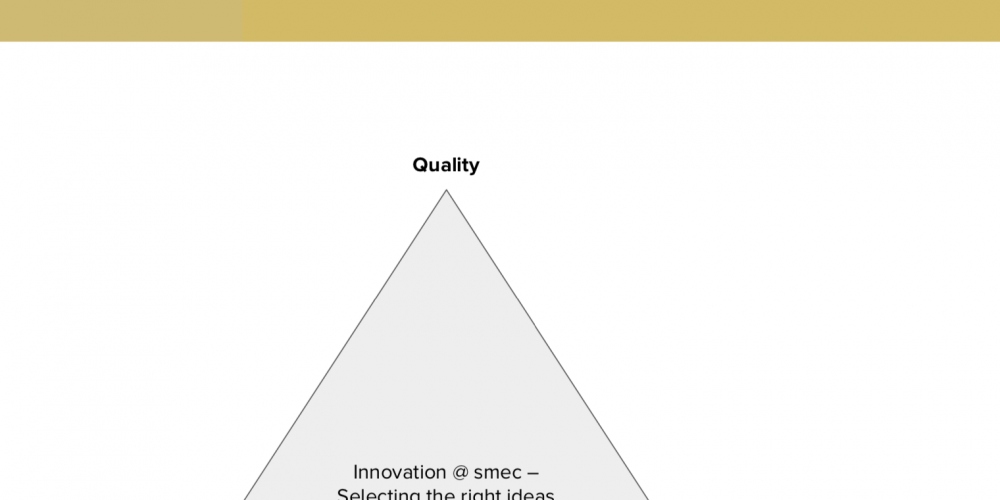Subscribe to join thousands of other ecommerce experts

One of the hardest challenges in all innovation processes is keeping the focus on what’s most promising. As a result, it is quite a difficult decision for any company to differentiate between good and better ideas. Moreover, there is no company with infinite resources and therefore it will either focus its resources on the very best ideas or it will never complete anything. In this context, there is a very simple method for making this common challenge more tangible – the so-called target triangle or project management triangle:

Although it was created for project management rather than for innovation (which is by far not as predictable), but still the rules apply as well. It all boils down to one simple thought: If you are trying to execute every idea, you either increase time to market to infinity or you are going to invest infinite resources – otherwise you would have to accept a terrible output quality.
Table of Contents
Quality gates to refocus constantly
Before implementing our new innovation process at smec, we screened many different approaches towards innovation. Quite a lot of them were really inspiring, some showed a somewhat too strong focus on either product-related or service-related innovation. For this reason, we have decided for a cherry-picking approach, to combine the best ideas fitting to our company’s culture and values: Excellence, Passion, Integrity and Cleverness.
Currently, our innovation process is divided into four phases with quality gates following each phase. While the effort is quite low in the first phase, it at least triples with every quality gate passed. As a result, all efforts need to be at an acceptable level and therefore it is necessary to reduce the number of initiatives drastically – after every quality gate. Furthermore, it is important to learn and improve as fast as possible in order to get a good feeling whether the idea is worth presuming.
Phase #1: Ideate
Most innovation ideas are already quite concrete and sound a little bit like “we should develop this in order to achieve that”.
The first step of our innovation process is kind of a speed bump for ensuring that we are not very enthusiastic only – which we are – about a new feature or technology. It mainly consists of two hours in a workshop-based and very short pre-pitch (one minute, one slide) – using the Value Proposition Design method.
Here we try to increase the emotional distance to our first idea and focus on the value proposition we aim to achieve, as well as the market segment we need to address.
Based on the results, we are thinking about different approaches regarding how to deliver this value proposition to the client in Phase 2 of our innovation process.
And this may lead to three possible outcomes:
- The idea passes this quality gate and we start a new innovation initiative.
- We decide it is more about optimizing an existing product or service and hand over the idea to smec’s responsible Product Owner and/or Segment Manager.
- The idea is great, but it is not the right moment to further pursue it within our innovation process.
Phase #2: Improve
This is the creation phase in our innovation process where we elaborate on how we could actually fulfill a (potential) client’s needs based on the results of the previous phase.
Also, it includes opening up for concepts and then choosing the three most promising ones for the following steps. In our innovation workshops, we use a wide variety of innovation tools and methods, but key to success is having a diverse group of participants with different backgrounds, different levels of experience and different roles within our organization.
The next steps are designed to find the right concept, a single one where our initiative team sees the highest potential in it and therefore this one should really pass the first pitch of our innovation process. For this purpose, we use innovation methods such as the Business Model Canvas, the Mission Matrix, common methods for market research, risk assumptions and even a legal screening. At the end of this phase, we really want to make sure that we have found a raw diamond.
This can lead to four possible outcomes:
- The recommended concept passes this quality gate and we start digging deeper into it.
- There is more than one concept recommended and so we split up the initiative.
- We cannot recommend any of the concepts we have seen so far. And yes, we will then have learned our lesson that there is no raw diamond in our hands at that point in time. (Nevertheless, it is still a positive learning outcome, as we can save resources for other more promising initiatives.)
- We are not sure about the recommended concept and ask the initiative team to rethink this phase.
Phase #3: Investigate
In this phase we are drilling deep into the selected concept with different methods (SWOT, feasibility testing, scenario analysis etc.): We will collect and list our assumptions, find ways to measure and prioritize them. And of course, we will discuss the concept with external confidants and close partners.
However, the most relevant question that definitely needs to be answered in the second pitch is: “What does it mean for us, if we follow this path?”. In other words, we have to be crystal clear what resources are necessary for a market test (Phase 4) and also, for the creation of a minimum viable product (MVP).
This usually unfolds in three possible ways:
- The innovation initiative passes the quality gate and we proceed with Phase 4.
- The results are not clear and therefore we ask the initiative team to rethink the concept itself.
- The prospects are clear but not very attractive and so we stop the initiative for now.
Phase #4: Iterate
This phase looks quite simple on the first glimpse. But still, all assumptions prior made with regard to the initiative need to be validated and furthermore, we need feedback from the client. As a matter of fact, the main goal is to receive valuable market feedback and find out whether we were correct in assuming what the client is looking for. And of course, we need an MVP for this phase so that we have something our target segment is waiting for. What we have already experienced is that this way of selling – and not giving it away for free – is genuinely necessary in order to get honest feedback, as humans are not too critical in general when things are free. But still, we need an honest assessment to learn – or fail – fast.
As a result, we design our MVPs in a way that they deliver us all the information needed to verify our assumptions during the market test. However, they do not have to be perfect in the beginning, but we better work on improving them fast, based on the feedback of complaisant clients involved in our market test.
Overall, this phase ends when Pitch 3 is taking place in front of our management board, containing all results of our market test, as well as a final concept and a business plan.
Again, there are three possible outcomes:
- The presented innovation initiative passes this quality gate and a new product or service will be launched.
- The results are not clear enough, but we still believe in the concept – this usually results in restarting the initiative in our innovation process.
- We have learned a lot during our market test and came to the conclusion that the initiative should not be offered as a product or service by smec.
As a matter of fact, the hardest part of the innovation process is to decide whether or not to keep following a certain initiative. Nevertheless, this step is crucial for finding real raw diamonds leading to a potential success. So besides learning and failing fast, the true challenge is to constantly refocus on what really matters. And this is often hard enough and quite a task for any business organising their innovation potential in a professional way.
Read more about innovation at smec:
How lean can Lean Innovation really be?

